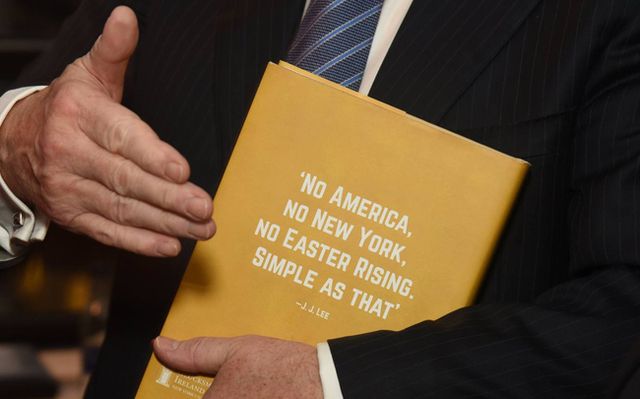2016 has been an extraordinarily busy year at New York University’s Glucksman Ireland House. Over the past two years, the world-renowned Center for Irish and Irish American Studies has been engaged in research on aspects of the American role in the 1916 Easter Rising. This study has culminated in the recent publication of a seminal volume on this topic, Ireland’s Allies: America and the 1916 Easter Rising, edited by Miriam Nyhan Grey (UCD Press, 2016). Renowned historian J. J. Lee has observed, ‘No America, no New York, no Easter Rising. Simple as that.’ Ireland’s Allies: America and the 1916 Easter Rising interrogates that assertion by placing the Rising in Dublin in a transnational setting, thereby making a contribution to our understanding of ethnic allegiances in neutral America and to the mechanics of revolutionary networks and diaspora nationalism. The United States provided an important post-colonial republican model for the Irish in 1916 who drew on that legacy.
The scope of this research strategy has been broad both geographically and in terms of the profile of the scholars involved. Chapters originated from faculty based at Glucksman Ireland House NYU as well as well-known historians across the United States and in Ireland. One of the most gratifying aspects of this project has been to see research emerge from students in NYU’s Master of Arts in Irish and Irish-American Studies program housed at Glucksman Ireland House. In fact, seven of the twenty-four chapters in this weighty volume were authored or co-authored by individuals who have undertaken this unique graduate program which focuses innovatively on the Irish-American experience. A research initiative that encompassed the work of graduate students demonstrates the confidence of a program now almost a decade old.

The contributions from graduate-student research include:
- A chapter on the Tyrone-born activist Joseph McGarrity. Maura Anand, Andrew Hicks, and R. Bryan Willits’s novel examination of the guests to McGarrity’s home in 1914 (including Padraig Pearse and Roger Casement) confirms the need for historians of diaspora nationalism to pay more attention to McGarrity.
- R. Bryan Willits’s chapter has done a great service to scholars by deploying the German-American press to translate, quite literally, exactly what was reported about Ireland and how, more generally, German-Irish relations evolved in the period circa 1916.
- Sligo-born U.S. congressman William Bourke Cockran was a world-famous orator who influenced American and global politics at the highest level for many decades. Patrick Sweeney innovatively uses examples of Cockran’s speeches to convey his role in shaping public and political opinion on Ireland in the United States.
- To date, many scholars have paid but cursory attention to the significance of Padraig Pearse’s American visit, but Maura Anand’s meditation causes us to rethink just how impactful this actually was. Anand lingers on what one scholar has described as ‘the most formative three months of his life.’
- During his time in New York Pearse, who was a pioneering educator, inspired a 23-year-old American named John A. Kilgallon to leave his home in Queens, New York, and travel to Ireland to study. Kilgallon would see combat in Dublin in 1916 and was subsequently interned in Frongoch before being deported back to the United States. Ed Shevlin, in collaboration with NYU faculty member Marion R. Casey, uses newly-available sources to reconstruct Kilgallon’s life both before and after his formative experiences in Ireland.
- The stance taken by the Irish-born John Cardinal Farley reflects the outlook of the New York hierarchy on matters pertaining to Ireland in this tumultuous period. NYU alumna Kate Feighery’s stimulating chapter draws on the example of the 1916 Irish Relief Fund by exposing an inherent disconnect between the Church and its Irish-American flock.
- New York reacted vocally to news of the Rising. A color poster portraying James Connolly’s execution (commissioned to publicize the October 1916 fundraising bazaar at New York’s Madison Square Garden) is used by NYU alumna Daphne Dyer Wolf to re-cast the memory of the agitator who, in life, had been often ignored by Irish America. Wolf’s thoughtful treatise, reflecting on the period Connolly spent living in New York, prompts consideration of depictions of Connolly’s death.

The dynamism of Glucksman Ireland House NYU draws further attention to the opportunities for the MA in Irish and Irish American Studies. Open Houses for the MA program will take place from 5pm - 6.30pm, Thursday 26 January, 2017 and Thursday March 9, 2017 for prospective applicants interested in hearing the experiences of alumni and meeting faculty. Please RSVP via this link or email [email protected]
Ireland’s Allies: America and the 1916 Easter Rising, edited by Miriam Nyhan Grey, is available via www.ucdpress.ie




Comments